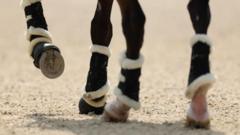How Did a 37-Year-Old Horse Rider Tragically Die After a Fall?

Tragic Incident at Aston-le-Walls Horse Trials: Remembering Sarah Yorke
The equestrian community is mourning the loss of 37-year-old Sarah Yorke, who tragically died following a fall during the Aston-le-Walls Horse Trials in Northamptonshire. This heartbreaking incident not only highlights the risks associated with competitive riding but also emphasizes the close-knit nature of the equestrian world, where the impact of such a loss resonates deeply. British Eventing, the governing body for equestrian sports in Great Britain, has extended its condolences and announced a comprehensive review of the circumstances surrounding this tragic event.
The Incident: What Happened at Aston-le-Walls?
On Friday, during a competition at the Aston-le-Walls Horse Trials, Sarah Yorke suffered a fall at a fence. Immediate medical assistance was provided on-site, but unfortunately, she succumbed to her injuries shortly thereafter. The incident led to the event being abandoned, as announced by British Eventing, following what they described as a "serious incident." This decision reflects the governing body's commitment to safety and the well-being of all participants.
British Eventing’s Chief Executive, Rosie Williams, expressed her sorrow and offered condolences to Yorke's family and friends in a heartfelt statement. "The thoughts of the entire eventing community are with [Ms Yorke's family] at this incredibly difficult time," she stated, underscoring the profound impact this loss has had on the equestrian community.
The Response from British Eventing
In light of the tragedy, British Eventing has committed to conducting a full review of the incident in line with their established protocols. This review aims to analyze the circumstances of the fall and assess any potential areas for improvement in safety measures and event management. The organization’s proactive approach signifies their dedication to ensuring the safety of riders and horses during competitions.
The Importance of Safety in Equestrian Sports
Equestrian sports, particularly eventing, involve a unique blend of skill, bravery, and risk. Riders face various challenges, including jumps and obstacles that require precision and control. Despite extensive training and safety regulations, accidents can occur, making it crucial for governing bodies like British Eventing to continuously review and enhance safety protocols.
Understanding Eventing Risks
Eventing combines dressage, cross-country, and show jumping, each presenting its own risks. Here are some critical factors contributing to the inherent risks in eventing:
- Complex Obstacles: Riders must navigate various jumps, including ditches, water, and tricky combinations, which can lead to falls.
- Speed and Control: The speed required in cross-country events can amplify the consequences of any misjudgment.
- Horse Behavior: Horses are unpredictable animals, and their reactions can influence a rider’s safety.
- Terrain Conditions: Uneven or slippery ground can increase the likelihood of accidents.
Community Support and Mourning
The aftermath of such incidents often sees a profound outpouring of support from the equestrian community. Friends, family, and fellow riders come together to honor the memory of those lost. Memorial events and tributes serve as reminders of the passion and dedication that riders like Sarah Yorke brought to the sport.
The Role of Mental Health in Equestrian Sports
In addition to physical safety, the mental health of riders is an essential aspect of their overall well-being. The pressures of competition, coupled with the emotional toll of losing a fellow rider, can be overwhelming. It is vital for the equestrian community to foster an environment of support and understanding, allowing individuals to express their grief and seek help when needed.
Future of Equestrian Safety Protocols
The review initiated by British Eventing may lead to the implementation of enhanced safety measures. Potential areas for improvement include:
- Increased Training for Officials: Ensuring that event officials are well-trained in emergency response can help mitigate risks.
- Improved Medical Availability: Having more medical personnel on-site during events can provide immediate assistance in emergencies.
- Upgraded Equipment: Utilizing better-designed fences and safety gear can reduce the likelihood of serious injuries.
- Rider Education: Ongoing education about safety protocols and risk management is essential for all competitors.
Embracing Community Resilience
As the equestrian world processes the loss of Sarah Yorke, it is crucial to embrace resilience and community support. The spirit of camaraderie among riders, trainers, and fans can aid in healing and remembrance. Organizing events that celebrate her life and contribution to the sport can help foster connection and solidarity within the community.
How Can You Support the Equestrian Community?
There are various ways to support the equestrian community during difficult times. Consider the following actions:
- Participate in Memorial Events: Join or organize events that honor fallen riders.
- Advocate for Safety: Support initiatives that promote safety in equestrian sports.
- Provide Emotional Support: Reach out to fellow riders or community members who may be struggling.
Conclusion: A Call to Remember and Reflect
The tragic passing of Sarah Yorke serves as a somber reminder of the risks involved in equestrian sports. As the community comes together to grieve and remember her, it is essential to reflect on safety measures and emotional well-being. While the loss is profound, it can inspire positive changes that enhance the sport for future generations.
Frequently Asked Questions
What happened to Sarah Yorke at the Aston-le-Walls Horse Trials?
Sarah Yorke fell during a competition and tragically died from her injuries, prompting British Eventing to abandon the event.
What are the risks associated with eventing?
Eventing involves complex obstacles, speed, horse behavior, and terrain conditions, all of which contribute to inherent risks.
How can the equestrian community support each other after such incidents?
Community members can support each other by participating in memorial events, advocating for safety, and providing emotional support to those in need.
As we reflect on the life of Sarah Yorke, let us strive for a safer and more supportive equestrian community, ensuring that the spirit of those we’ve lost continues to inspire us. How can we enhance safety and support within our own riding communities? #EquestrianSafety #RememberingSarahYorke #SupportEquestrianCommunity
Published: 2025-08-09 18:21:13 | Category: technology



